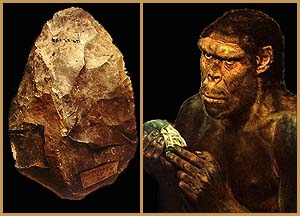
Hominid Species Time Line
Page 26
Tool use and adaptation to the environment
Homo erectus was an accomplished tool-maker and tool user. Hand-axes like the one below left are widely distributed across hundreds of sites on three continents. The tools of Homo erectus are the first in the fossil record to show conscious design of any complexity. Amazingly, and presumably without the use of a fully developed language, H. erectus was able to transmit both the concept of this leaf-shaped tool and the techniques for making it to subsequent generations for over a million years. They also used sharp flakes produced in the fashioning process. Wooden tools and weapons are also assumed to be present in the tool kit of this species, but none has been preserved in the fossil record.

H. erectus was probably the first species to use and control fire. This milestone in human development occurred 1 to 1.6 million years ago, or perhaps even earlier. Control of fire was surely instrumental in allowing humans to adapt to colder climates in Europe and Asia. The date of the earliest human control of fire will probably remain elusive; nonetheless, we know that human species expanded into many new environmental niches outside of Africa, with or without fire, by 2 million years ago.
The painting below left depicts a small band of Homo erectus foraging for food in the tropical forests of Java; the painting below right shows the same species adapted to the terrain and climate of northern China.

These two paintings illustrate the view that this species represented the first humans to exploit its environments somewhat like modern hunter-gathers, killing at least small animals as well as scavenging, and exploiting a wide variety of plant materials.
Some Homo erectus sites in China preserve evidence of cannibalism, though it has been speculated that perhaps these acts were ritual rather than predatory behavior. One H. erectus skull at Bodo in Africa shows signs of having been scalped. The meaning of such behavior is difficult to reconstruct from limited evidence.